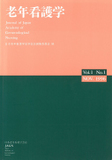Japanese
English
- 販売していません
- Abstract 文献概要
- 参考文献 Reference
在宅虚弱高齢者の日常生活の過ごし方からその後のADLの変化を予測することは,在宅看護を展開するうえで必要なことである.本研究では,日常生活の過ごし方を生活時間の実態から把握し,生活パターンを見出した.さらにその生活パターンとADLの関連の探索を行った.65歳以上の高齢者54名に家庭訪問を行い,生活調査を行った.その結果,1日の大半をテレビを見て過ごす虚弱高齢者の生活実態が把握された.高齢者の自由時間の過ごし方によって臥位休息型,座位休息型,趣味型,散歩型,家事型の生活パターンが見出された.また家事型が有意に他群よりも,散歩型は座位休息型,臥位休息型よりもADLが有意に高かった.虚弱高齢者の自由時間の過ごし方に着目することからその生活パターンの変化を把握し,ADL低下につながらないように援助を行うことが重要であると提言することができた.
It is an essential component for nursing to assess the daily life of home frail elderly, in order to care for them to make the most of their physical ability. The purpose of this study was to know home frail elderlys' time use and find their daily life patterns. And the relationship of their life patterns to ADL (activities of daily living) was explored. Frail elderly was defined as elderly who are independent inside home but need assist when they go out. ADL was measured by Barthel Index and TMIG Index of Competence. Fifty-four home elderlys over 65 years of age were visited by a researcher and detailed time budgets for one full day were obtained from them. The result showed a large proportion of the elderlys' time was spent in resting and watching TV. Five daily life patterns were categorized by their discretionary activity. They were Lying rest pattern, Sitting rest pattern, Hobby pattern, Walking pattern, and Houseworking pattern. The mean score in index of ADL of Houseworking pattern elderly was significantly highest of all, and that of Walking pattern elderly was significantly higher than Lying rest pattern elderly and Sitting rest pattern elderly. The study suggested that it is important for nurses to pay attention to elderlys' discretionary activity and a little change of their daily life patterns to avoid their ADL decline.
Copyright © 1996, Japan Academy of Gerontological Nursing All rights reserved.


